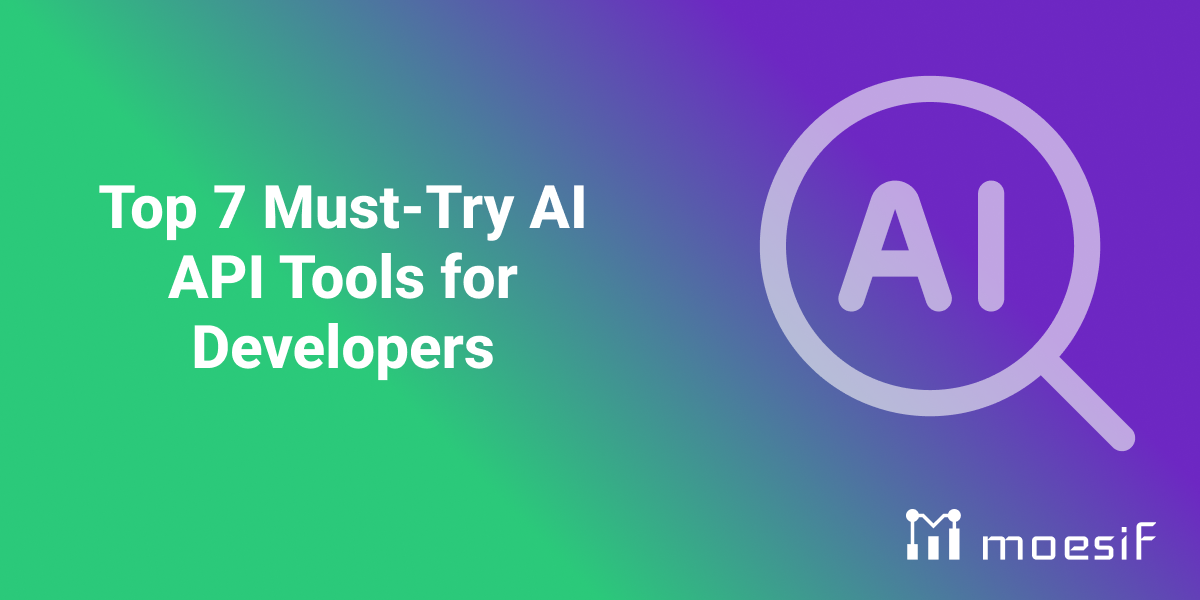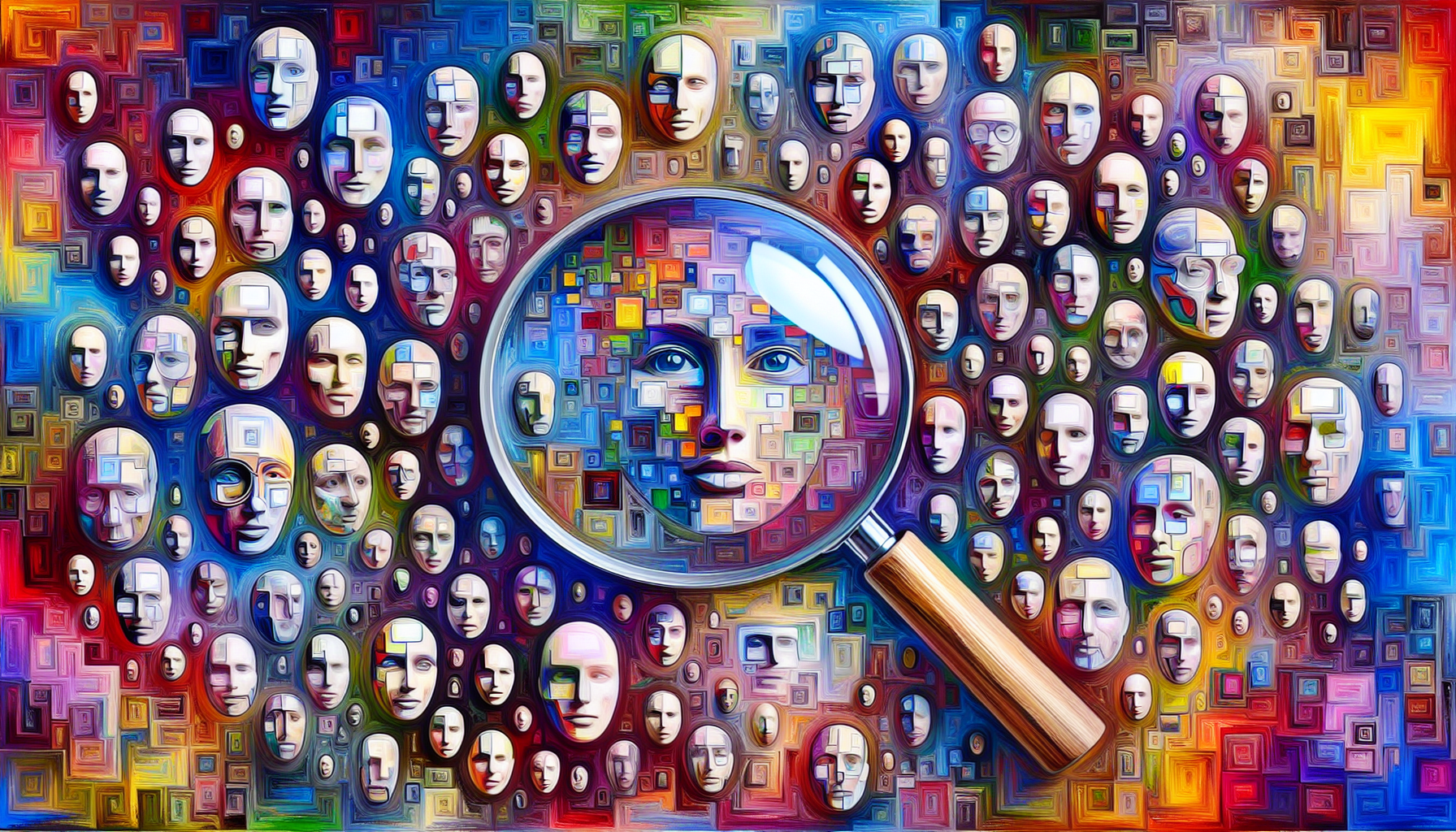Top 7 Must-Try AI API Tools for Developers

Upon close inspection of the growing adoption of artificial intelligence across different industries, it becomes apparent that a lot it rests on the shoulders of API-powered systems. A survey by McKinsey found that 56% of respondents reported AI adoption in at least one function within their organizations, with significant increase in the use of AI APIs for tasks like natural language processing and computer vision.
AI APIs have improved the accessibility to AI and simplified the process of adding AI features to applications. Consequently, it’s also made deployment and maintenance of AI systems easier as well since the AI analytics part and the software code aren’t tightly coupled anymore.
In this article, we cover the top tools to quickly integrate functionalities like natural language processing and image recognition into your applications. We start by understanding what artificial intelligence APIs are. Then we discuss the different types of AI APIs. Finally, we briefly explain how you can choose the most perfect tool for your use case and integrate it into your application.
Table of Contents
- Table of Contents
- Key Takeaways
- Understanding AI APIs
- Types of AI APIs
- Top AI API Tools
- Choosing the Right AI APIs for Your Project
- Integrating AI APIs into Applications
- Future Trends in AI APIs
- Summary
Key Takeaways
- AI APIs enable developers to incorporate advanced AI functionalities into applications without needing deep AI expertise. For example, you can add natural language processing, image recognition, and speech processing to enhance your apps.
- Top AI API tools include Google Cloud AI Products, OpenAI API, IBM Watson AI, Hugging Face APIs, DeepAI, Stream’s Auto Moderation, and Imagga. Each offers various specialized capabilities from text analysis and image recognition to content moderation.
- When selecting AI APIs, you must take some key considerations into account. For example, understanding specific project needs, ensuring compatibility with existing systems, evaluating cost-effectiveness, and examining the provider’s reliability and security measures.

Understanding AI APIs

APIs form the foundation of modern software development. They give developers many benefits:
- Leveraging existing functions and services. This eliminates the need to build everything from scratch and thus saves significant time and effort.
- Facilitating efficient data access and sharing across various platforms. It makes interactions seamless and therefore greatly enhances user experiences.
- Supporting interoperability between diverse software applications, making systems more modular and scalable.
With AI APIs, developers can incorporate sophisticated AI functionalities into their applications, bypassing the need for in-depth AI or machine learning expertise. AI integration provides applications with advanced functionalities like natural language understanding, image recognition, and speech processing.
So, how do AI APIs function? They leverage advanced machine learning models and algorithms to provide intelligent functionalities. These models, including those for natural language processing (NLP), continuously learn and improve from new data. This means that APIs remain accurate and their performances improve over time. This dynamic improvement allows applications to become smarter and more efficient without additional development efforts.
What is an AI API?
AI APIs, just like traditional APIs, act as intermediaries. They allow you to integrate AI services into software applications without the need to build these services from scratch. With APIs, various software systems can interact with one another and exchange information effortlessly. Modern applications often need to pull in data from multiple sources and provide seamless user experiences. As our digital experiences have been shifting over to AI-powered features, AI APIs have naturally become a critical component of software systems.
Integrating an AI API into your application essentially bridges your app to powerful AI models and data processing features. For example, tasks such as text analysis, image recognition, and speech processing. When specialized AI services handle these tasks for your application, you get a more efficient and capable application that can offer advanced features to users.
How AI APIs Work
The secret of AI APIs rests in the advanced technologies they use under the hood. Some of these technologies include:
- Natural language processing (NLP). It allows APIs to understand and generate human language by analyzing syntax, semantics, and context.
- Text analysis. It allows APIs to analyze and extract information from text.
- Sentiment detection. It helps APIs determine the sentiment or emotion in text.
- Entity recognition. This allows APIs to identify and classify different entities mentioned in text.
AI APIs also act as interfaces to access and utilize machine learning models. Powerful machine learning algorithms drive these ML models that often require large workloads and powerful machines. Having AI/ML models run as services behind API endpoints so that applications can freely call those endpoints marks significant progress toward AI democratization.
An AI API gives you a clean interface between the analytics and the apps that use them. You don’t have to worry about running and hosting the models. The end result brings faster development cycles and reusability.
Benefits of Using AI APIs
AI APIs significantly increase the efficiency of development processes. Developers can focus on building new features and improving user experiences without having to start from scratch. The scalability of AI APIs works as a compliment, handling growing amounts of data and user interactions as a product grows.
AI APIs also make applications more flexible and interconnected. Real-world implementations of AI APIs show significant advancements in user experience through automation and personalization. For example:
- Companies like Amazon and Netflix utilize AI APIs for recommendation engines. These APIs analyze user behavior, purchase history, and preferences to suggest products or content tailored to individual users.
- Platforms like Google Translate leverage AI APIs for real-time translation of text and speech.
- AI-powered chatbots, for example in Intercom or Drift, use natural language processing (NLP) APIs to understand customer inquiries and provide instant support. This automates routine tasks, improves response times, and improves customer satisfaction.
Types of AI APIs

Various types of AI APIs exist to fulfill specific needs and functionalities. For example:
- Computer vision APIs for image recognition.
- Speech recognition APIs for converting audio to text.
- Natural language processing APIs for understanding and generating human language.
- Translation APIs for breaking down linguistic barriers.
Each type of AI API offers unique capabilities that you can leverage to enhance your applications in specific ways.
Computer Vision APIs
Computer vision APIs, including optical character recognition can analyze and understand visual content in images and videos. These APIs can perform tasks such as image classification, object detection, and facial recognition. In applications ranging from security to social media, these features open up a lot of possibilities. For instance, Google Cloud Vision API can classify images into thousands of categories and detect individual objects and faces.
Beyond basic image recognition, these APIs also support advanced features like text detection and video analysis. Google’s Video Intelligence API, for example, can recognize objects, places, and actions in both stored and streaming video, making it a versatile tool for video content analysis.
Speech Recognition APIs
Speech recognition APIs have several key features:
- They convert audio files into text, so applications can understand and respond to spoken language.
- They support real-time transcription for live audio streams, making them ideal for applications like live captioning and voice-controlled interfaces.
- They offer speaker identification. In scenarios where multiple speakers are present, this can prove very useful.
- They provide language detection, allowing applications to identify different languages people speak.
These features make Speech recognition APIs a powerful tool for a wide range of applications.
Developers can integrate speech recognition APIs to create applications that offer voice control features and support for multiple languages. This allows you to create accessible applications for users with disabilities or in enabling hands-free operation in various contexts.
Natural Language Processing APIs
Natural language processing (NLP) APIs leverage natural language processing models to analyze and understand human language. These machine learning models can perform a variety of tasks, including sentiment analysis, text classification, and entity recognition. Applications that require deep language understanding often use NLP models through APIs. For instance, OpenAI’s models can translate languages, summarize text, and answer specific questions.
NLP APIs also support custom models that you can tailor to specific use cases. Whether you need to analyze customer feedback, automate content moderation, or build conversational agents, NLP APIs provide the tools necessary to extract valuable insights from text data.
Translation APIs
Translation APIs bridge linguistic barriers by supporting multiple languages. They offer features like dynamic results and domain-specific customization. They use advanced neural machine translation models to provide high accuracy and fluency for applications that require reliable and nuanced translations.
In professional settings, these APIs become invaluable tools for their ability to accurately translate specialized jargon.
Top AI API Tools
Let’s explore the top seven AI API tools that every developer should consider.
Google Cloud AI Products
Google Cloud offers a suite of AI products that include:
- Translation API
- Speech-to-Text API
- Natural Language API
- Video Intelligence API
These tools, including large language models, provide powerful capabilities such as real-time translation, sentiment analysis, and image classification.
Google Cloud’s free AI tools make it accessible to developers to experiment and integrate advanced AI features to their applications.
OpenAI API
OpenAI API is known for its general-purpose “text in, text out” interface that supports a wide range of tasks. These include language translation, content generation, and sentiment analysis. The API leverages models from the GPT-3 family. These models possess superior speed and throughput, to generate human-like text based on given prompts. The OpenAI API has become a versatile tool for developers looking to integrate advanced NLP capabilities into their applications.
Furthermore, users can ‘program’ the OpenAI API by providing examples of desired outcomes. This allows the API to learn from human feedback and improve its performance.
IBM Watson AI
IBM Watson AI offers robust tools for developers including natural language processing, speech-to-text and text-to-speech conversion, and creating custom models. Its Natural Language Understanding (NLU) API, for instance, analyzes text to extract valuable insights such as entities, keywords, and sentiment.
If your applications require deep text analysis and understanding, you can’t go wrong with IBM Watson.
Hugging Face APIs
Hugging Face’s Inference API supports a variety of NLP tasks, including:
- Text generation
- Text classification
- Named entity recognition
- Zero-shot classification
- Table question answering
It also handles advanced tasks using NLP, audio, and computer vision models through API calls, making it a versatile tool for developers.
DeepAI

DeepAI offers a text-to-image API that allows you to generate images based on text input, supporting 29 different styles. The API supports several programming languages, including:
- JavaScript
- Python
- Ruby
- C#
This makes it accessible to a wide range of developers.
Stream’s Auto Moderation
Stream has designed its Auto Moderation API for content moderation in real time. It can flag prohibited content, and remind users about community standards. It provides valuable information for moderators to review and take appropriate action, ensuring a safe and respectful community environment.
Imagga

Imagga’s API supports a wide range of image processing capabilities, such as:
- Visual search
- Face recognition
- Tagging
- Cropping
- Coloring
- Categorizing images
This allows users to efficiently utilize various tools for enhancing and analyzing their image content. Developers can try the free version to check for compatibility and response rates before committing to a pricing plan.
Choosing the Right AI APIs for Your Project
To select the most appropriate AI API for your project, you must carefully consider your unique needs, scalability requirements, and compatibility with pre-existing systems. You also need to evaluate how an AI API can meet your project’s objectives and ensure it can handle future growth.
Factors to Consider
When selecting an AI API, consider the following factors:
- The specific tasks your project needs to accomplish, such as natural language processing or computer vision
- The flexibility of the API when it comes to customization to meet your unique requirements, including the ability to fine-tune and adjust parameters.
- The pricing models and financial planning, to effectively manage your budget.
You must also consider the reliability and security factors. Ensure the AI API provider offers robust documentation and support for smooth integration and troubleshooting. To protect sensitive project and customer data, carefully evaluate the data security measures as well.
Comparing AI API Providers
To simplify the process of comparing AI API providers, focus on your key criteria.
Cost-effectiveness becomes crucial for projects with tight budgets. Providers like Llama 3.1 (8B) offer competitive pricing, making them a cost-effective choice for various applications.
Evaluate how the features of each AI API align with your project’s needs. Depending on specific use cases, each API provides value differently.
In addition to cost, consider the unique features and benefits each provider offers. Determine which AI-powered APIs would drive the most value for your niche and audience, prioritizing user safety, convenience, and satisfaction.
By aligning the provider’s strengths with your project’s requirements, you can make an informed decision that maximizes both performance and budget.
Integrating AI APIs into Applications
The integration process of an AI API into an application depends on the provider. However, the integration process contains some best practices and general steps across a majority of the providers. Let’s discuss those.
Obtaining API Keys
API keys act as unique identifiers for authentication and authorization when accessing AI APIs. Users typically obtain these keys through the service provider’s developer portal or API management console. Developers need to sign up for a developer account and register their project to receive an API key.
You must store these keys securely, often using environment variables, to prevent unauthorized access.
Setting Up API Calls
Setting up API calls involves the following steps:
- Make HTTP requests to the API endpoints using the obtained API key.
- Include necessary headers and parameters in your requests to authenticate and specify the data required.
- Utilize libraries or packages specific to your development environment to simplify the process of making API calls and handling responses.
Handling API Responses
When handling API responses, implementing error-handling mechanisms ensures that your application gracefully handles issues such as rate limits and service unavailability. Your end users expect a meaningful error message. As developers, any response error should contain enough log information and an error code that informs exactly what went wrong. This makes debugging fast and easier.
For successful API responses, you want to parse the data appropriately to extract the useful bit of information and integrate it into your applications.
Future Trends in AI APIs
AI APIs, powered by artificial intelligence, have a promising future. Some of the key trends to stay updated on include:
- Improved machine learning models.
- Enhanced natural language processing.
- Advanced computer vision capabilities.
- Increased automation and efficiency.
- Integration with IoT devices.
Advances in Machine Learning Models
Advancements in machine learning models have been driving significant improvements in AI APIs. Technologies like Google’s AutoML produce high-quality models for natural language processing tasks. Federated learning, which trains models on multiple devices without sharing data, is gaining traction for maintaining data privacy in sensitive fields like healthcare and finance.
TinyML enables machine learning on low-power devices. It’s transforming applications in wearable technology and IoT by enabling real-time processing and decision-making. The focus on ethical AI is also growing, with an emphasis on developing transparent and accountable machine learning models.
Enhanced Natural Language Processing
Researchers and developers are pushing for better quality control and accuracy in natural language processing (NLP). Enhanced NLP capabilities are reducing errors and improving user experiences, making applications smarter and more reliable. We observe a growing number of applications that rely heavily on language understanding and generation. Therefore, advancement in the NLP space can further drive innovation forward.
Integration with IoT and Edge Computing

The integration of AI APIs with IoT and edge computing is revolutionizing real-time decision-making and enhancing privacy. Some benefits of this integration include:
- Reducing latency and power consumption in IoT devices.
- Enabling immediate data processing and action.
- Improving real-time responses in applications such as smart homes, industrial automation, and healthcare.
Applications in smart homes, industrial automation, and healthcare, use these features to deliver real-time responses.
Federated learning’s decentralized approach is highly compatible with IoT. This ensures data privacy while leveraging diverse datasets. This combination of technologies allows us to build more secure and efficient AI applications that can operate independently of centralized cloud services.
Summary
AI APIs are transforming the landscape of software development by providing powerful capabilities in software systems. From computer vision and speech recognition to natural language processing and translation, the types of AI APIs available today offer developers unprecedented opportunities to enhance their projects.
However, choosing the right API remains a challenge that we need to sensibly tackle. It not only involves considering project requirements, scalability, and compatibility but also the growing concerns around the ethical use of AI. Nevertheless, we see progress and significant efforts behind ethical AI systems. The adoption of ethical frameworks, ethical boards and committees, and the development of tools that mitigate AI risks have been growing positively.
As AI technology continues to evolve, the potential for AI APIs will only grow. So leveraging them to the fullest will become essential for a sustainable future. Developers need to stay informed about the latest tools and trends and be mindful of the impact of the tools they choose.
For AI products, it’s very important to identify the metrics relevant to success and then effectively track them. Monetizing AI APIs also comes with challenges. AI APIs are inherently complex compared to traditional APIs. How they relate to different layers of an organization also follows sophisticated patterns. Therefore, you want a dedicated tool for monetization that addresses those challenges.
Moesif has been designed from the ground up to provide a unified platform to address these concerns. It comes with a comprehensive suite of powerful analytics and monitoring tools, along with robust monetization features. With these two, you can grow your AI product with confidence.
To try it yourself, sign up today for a free trial, no credit card required.





